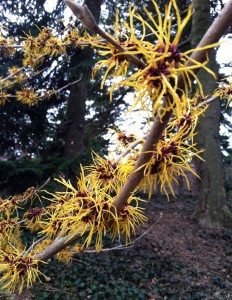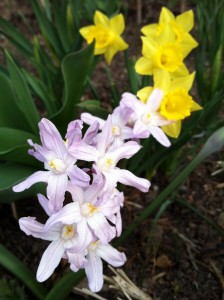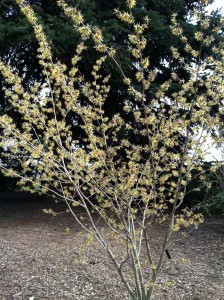Spring is Finally Here!
Posted in Around the Garden on April 9 2013, by Sonia Uyterhoeven
Sonia Uyterhoeven is the NYBG‘s Gardener for Public Education.

It’s come in fits and starts this year. Snow falls one day, only to vanish in an instant through heat or a heavy rain. With all the yo-yoing we have experienced this winter, oscillating from warm to cold, the fluctuating temperatures have sent me and many of my colleagues home with lingering ailments as our bodies try to figure out what’s going on.
While walking through the Garden in these early days of spring, I notice that Mother Nature is equally confused. The persistent cold has slowed down the cycle of spring, leaving us somewhere between one and two weeks behind schedule in terms of spring bloom. Once the warm temperatures arrive in earnest, things will accelerate. What this means for now is that some of the early signs of spring–the ones that we usually like to see from our living room windows–are out and worth perusing.
The Cornelian cherries (Cornus mas) started flowering around the very end of March this year, whereas they usually bloom sometime in the middle of the month. As one of the many cheerful harbingers of spring, they’re a welcome sight; the 15-foot, multi-stemmed branching shrub is smothered with tiny umbels bursting with golden yellow, star-shaped flowers.
The hybrid witch-hazels (Hamamelis x intermedia)–the crosses between Japanese and Chinese witch-hazels–generally start looking a little tired in early April after a few months of flowering, but the cool spring weather has fueled them to keep flowering like gangbusters. The cold keeps them fresh, extending their bloom time.

This year I have seen many beautiful variations of Hamamelis x intermedia ‘Barmstedt Gold’, alternatively dressed in snow or warming in the cool spring sun, exuding a mellow yet beautiful perfume. I love ‘Barmstedt Gold’ for her bossy yellow petals and the deep red calyces that add dimension and intensity to the bloom.
Another favorite of mine, new on my horizon this year, is Hamamelis x intermedia ‘Westerstede’. This witch-hazel also has the nice, upright vase shape of ‘Barmstedt Gold’ and falls in a similar size range–growing 8 to 12 feet tall–but has much paler yellow flowers which are absolutely divine. Both varieties have long and showy ribbon-like petals; ‘Barmstedt Gold’ has the slight witch-hazel crinkle to its petals, while those on ‘Westerstede’ have been neatly ironed out and extend like spines on a sea urchin. Witch-hazels tolerate deer and are low-maintenance shrubs that grow in full sun to part shade. If you haven’t discovered them yet, they are worth investigating to brighten up your yard in late winter and early spring.
That said, do you ever have one of those days where your intention is to do one thing, but you find yourself completely distracted by something else? You may not realize this, but that’s exactly what is happening to me at this moment–it’s not like me to get sidelined by talk of shrubs when I set out to discuss bulbs! So I am going to cram a few tidbits of information into a paragraph or two, because I think it is important for you to see bulbs in action in the spring. This should leave you better informed in the fall, when it comes time to make planting selections.

As of right now, one of my favorite minor bulbs is out in force in the Garden, known as glory-of-the-snow (Chionodoxa ‘Pink Giant’). As the name suggests, glory-of-the-snow is large in stature–about the size of a ‘Tete-a-Tete’ daffodil–with a nice, pinkish cast to it. We have it planted with the miniature trumpet daffodil (Narcissus ‘Little Gem’) in our Seasonal Border, forming a naturalistic drift in our entrance bed across from the train station.
In the Seasonal Border, these early spring bulbs intermingle with perennials, providing a good lesson for the homeowner. While the bulbs punctuate the entire Border, the ‘Little Gem’ is woven through Chinese astilbe (Astilbe ‘Vision in Pink’), with the bright yellow flowers of former complementing the rich, red new growth of the latter. Likewise, as the garden phlox (Phlox paniculata ‘Blue Paradise’) begins to emerge in the spring, its find young burgundy foliage is highlighted with ‘Pink Giant’. Not only is a color palette created with color harmonies and contrast, but the small bulbs–each of them ranging from 6 to 8 inches in height–will not interfere with the growth of the perennials. It is a very effective and healthy partnership.

